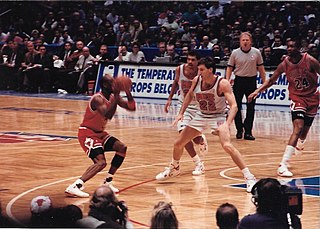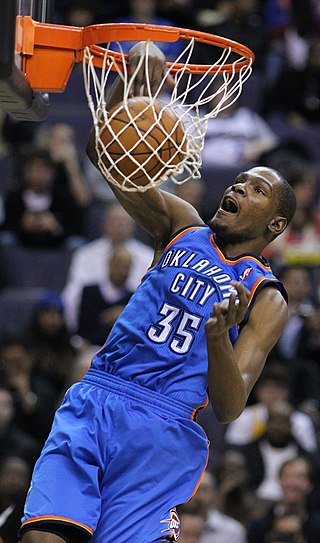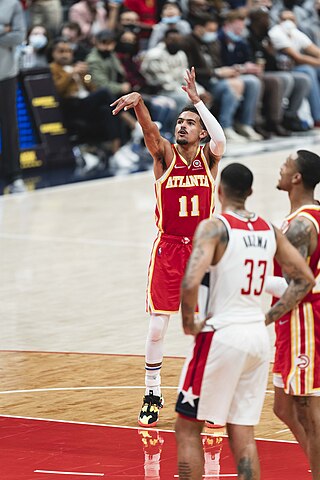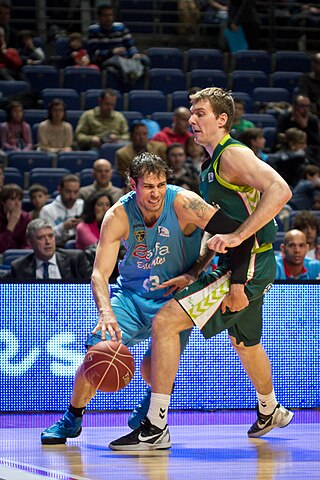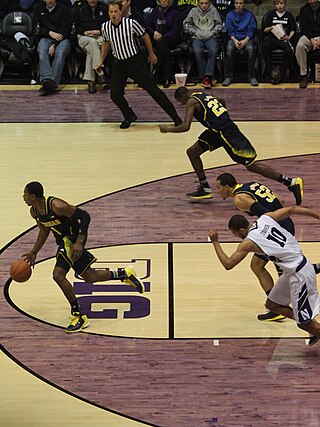Game play
Participants
Players
- Ball hog – A player who does not pass the ball, and takes more shots than everyone else.
- Bricklayer – One who repeatedly shoots bricks (Misses).
- Sixth man (also sixth woman or sixth player) – A player who does not start, but is generally the first person off the bench, and often has statistics comparable to those of starters.
Positions
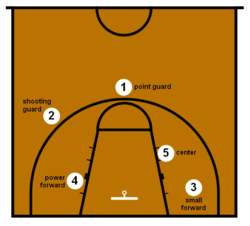
Basketball position – general location on the court which each player is responsible for. Players are generally described by the position (or positions) played, though the rules do not specify any positions. Positions are part of the strategy that has evolved for playing the game, and terminology for describing game play.
Primary positions
- Backcourt positions:
- Guard – One of the three standard player positions. Today, guards are typically classified in two broad categories:
- Point guard – has strong ballhandling and passing skills and is typically used to run the offense.
- Shooting guard – as the name implies, are generally the team's best shooters, and are very often the leading scorers on their teams.
- Guard – One of the three standard player positions. Today, guards are typically classified in two broad categories:
- Frontcourt positions:
- Center – One of the three standard player positions. Centers are generally the tallest players on the floor, responsible mainly for scoring, rebounding, and defense near the basket.
- Pivot – Another name for center
- Forward – One of the three standard player positions. Forwards are primarily responsible for scoring and rebounding.
- Power forward – position that plays a role similar to that of center in what is called the "post" or "low blocks". Power forwards typically play offensively with their backs to the basket and position themselves defensively under the basket in a zone defense or against the opposing power forward in man-to-man defense.
- Small forward – Typically smaller and quicker than power forwards, these players generally play on offense facing the basket, and very often attack the basket on offense. As with shooting guards, small forwards are often among their teams' leading scorers. Defensively, they will play on the perimeter of a zone defense, or against a physically similar opponent in a man-to-man.
- Center – One of the three standard player positions. Centers are generally the tallest players on the floor, responsible mainly for scoring, rebounding, and defense near the basket.
Tweeners
Tweener – a player who is able to play two positions, but is not ideally suited to play either position exclusively, so he/she is said to be in between. A tweener has a set of skills that do not match the traditional position of his or her physical stature. Tweeners include:
- Combo guard – Combines the features of both point guard and shooting guard.
- Forward-center – position for players who play or have played both forward and center on a consistent basis. Typically, this means power forward and center, since these are usually the two biggest player positions on any basketball team, and therefore more often overlap each other.
- Point forward – A forward with strong ballhandling and passing skills who can be called on to direct the team's offense.
- Stretch four – A player capable of playing either forward position. Term derived from the concept of a power forward ("4") capable of "stretching" a defense with outside shooting ability.
- Swingman – A player capable of playing either shooting guard or small forward.
Coaches
Coach –
Strategy
- Princeton offense – an offensive strategy which emphasizes constant motion, passing, back-door cuts, and disciplined teamwork. It was used and perfected at Princeton University by Pete Carril, though its roots may be traced back to Franklin "Cappy" Cappon, who coached Princeton Tigers men's basketball in the late 1930s.
- 1-3-1 defense/offense –
- Box-and-one defense – A combination defense in which four defenders play zone in a box formation and the fifth defender guards one player man-to-man.
- Continuity offense – pattern of movement, cuts, screens and passes that eventually leads back to the starting formation, and repeats.
- Hack-a-Shaq – The strategy of intentionally and repeatedly committing a personal foul against an otherwise skilled player who shoots free throws poorly. "Shaq" refers to Shaquille O'Neal.
- Jordan Rules –
- Man-to-man defense – A defense in which each player guards a single opposing player. See also zone defense.
- Motion offense – Category of offense involving a series of cuts and screens to create the best possible shot, with most or all offensive players moving simultaneously.
- Nellie ball – a fast-paced offense relying on smaller, more athletic players who can outrun their opponents and make more three-point attempts. Developed by NBA head coach Don Nelson. [11] This offense is most effective against teams that do not have the athleticism or shooting ability to keep up with the fast pace.
- Pack-line defense – A man-to-man defensive system in which one player pressures the ball and the other four players "pack" down within a "line" about 2 feet (0.6 m) inside the three-point arc, with the intent of stopping dribble penetration.
- Run and gun – combined offense and defense in which the team applies constant full-court pressure, while moving the ball forward as quickly as possible and taking the first available shot, often a three-pointer.
- Grinnell System – A further development of this style, created by Grinnell College head coach David Arseneault. The most striking feature of this system is that entire five-player units are usually substituted every 45 to 90 seconds, in a manner similar to an ice hockey shift.
- Shuffle offense –
- Small Ball – A strategy based in putting shorter players on the playing court, generally non-interior (positions 4 and 5) players
- Triangle offense – An offensive strategy with the goal of exchanging three (sometimes all five) positions, creating spacing among players and allowing each one to pass to four teammates. Originally established by University of Southern California head coach Sam Barry, this offense was later refined and perfected by one of Barry's former players, prominent college and NBA coach Tex Winter.
- Triangle and Two Defense – Similar to a box-and-one, except that in this variation, three defenders (usually the frontcourt players) play zone in a triangular formation and the other two defenders (usually the guards) play man-to-man.
- UCLA High Post Offense –
- Zone defense –
Plays
- Backdoor cut – offensive play in which a player on the perimeter steps away from the basket, drawing the defender along, then suddenly cuts to the basket behind the defender for a pass. The opposite of a V cut.
- Back screen – offensive play in which a player comes from the low post to set a screen for a player on the perimeter.
- Ball screen – offensive play in which a player sets a screen on the defender guarding the player with the ball.
- Baseline out-of-bounds play – the play used to return the ball to the court from outside the baseline along the opponent's basket.
- Box set – a formation in which four players align themselves as the four corners of a box. Often used for baseline out-of-bounds plays.
- Dribble drive motion – an offense that spreads the players to open up the lane for driving player to make a layup or kick out for a three-pointer.
- Fast break – an offensive tactic in which a team attempts to advance the ball and score as quickly as possible, giving the other team no time to defend effectively. Often the result of a steal or blocked shot.
- Fly fast break – after a shot is attempted, the player who is guarding the shooter does not box out or rebounds, but runs down the court looking for a pass from a rebounding teammate for a quick score.
- Four-point play – rare play in which a player is fouled but completes a three-point shot and then makes the resulting free throw.
- Halfcourt defense – portion of a team's defensive play conducted with both teams having established positions. See also transition defense.
- Halfcourt offense – portion of a team's offensive play conducted with both teams having established positions. See also transition offense.
- Memphis Attack – another name for dribble drive motion the offense was popularized in the early 2000s at the University of Memphis.
- Pick and pop – offensive play that is a derivative of the classic pick and roll. Instead of rolling toward the basket, however, the player setting the pick moves to an open area of the court to receive a pass from the ballhandler and "pops" a jump shot.
- Pick and roll – A play in which a player who is not the point guard sets a pick for the point guard, and rolls to the hoop.
- Three-point play
- A play in which a shooter is fouled while making a two-point shot and then makes the resulting free throw. See also and one.
- When a shooter is fouled while taking but missing a three-point shot and then makes all three free throws. This is rare.
- Transition defense – portion of a team's defensive play conducted when the other team has first gained possession and is moving up the court, before both teams have established positions. Includes defense against fast breaks. See also halfcourt defense.
- Transition offense – portion of a team's offensive play conducted when first obtaining possession from the other team and moving up the court, before both teams have established positions. Includes fast breaks. See also halfcourt offense.
Moves
Basketball moves – individual actions used by players in basketball to pass by defenders to gain access to the basket or to get a clean pass to a teammate.
- Free throw –
- Advance step – A step in which the defender's lead foot steps toward their man and the back foot slides forward.
- Air ball – An unblocked shot that fails to hit the rim or backboard. Does not reset the shot clock.
- Air pass – A pass that goes straight through the air to the receiver. See also bounce pass.
- Alley-oop – An offensive play in which a player throws the ball up near the basket to a teammate (or, more rarely, to himself) who jumps, catches the ball in mid air and immediately scores a basket, usually with a slam dunk.
- Euro step – An offensive move in which a player, after picking up the dribble, takes a step in one direction and the second allowed step in a different direction while driving to the rim.
- Field goal – A shot made from anywhere on the court, does not include free throws.
- Over the back – a foul committed by a player who tries to rebound the ball by pushing, moving or climbing on a player's back who is already in position to rebound the ball.
- Rebound – To obtain the ball after a missed field goal attempt.
Blocking and footwork
- Banana cut – A wide, curving cut, as opposed to a cut that is a straight line.
- Basket cut – A cut toward the basket.
- Blindside screen – A screen set directly behind a defender where the player can't see it.
- Block – To tip or deflect a shooter's shot, altering its flight so the shot misses.
- Block out – See "box out"
- Box out – To make contact with an opposing player to establish rebounding position between the player and the ball.
- Bump the cutter – To step in the way of a player who is trying to cut to the ball for a pass.
- Dingle – A steal that leads quickly to a score.
- Rip a C – A motion used while chinning the ball to create space during a pivot between an offensive player and a defensive player. Pivot towards the defender and rips the ball in a C-shape away from the pressure to create a passing lane.
- screen, set a screen – (v) To attempt to prevent a defender from guarding a teammate by standing in the defender's way. The screening player must remain stationary: a moving screen is an offensive foul. (n) The tactic of setting a screen. Also called a "pick".
- Stutter step – a common warm-up drill where you shuffle and scuff your feet in a quick moving motion across a length of flooring. This warm-up is supposed to keep the players alert and help them prepare to defend players in a real game, since the stutter step is a smaller version of shuffling.
Dribbling
Dribble – to bounce the ball continuously. Required in order to take steps with the ball.
- Wraparound – In the wraparound, the ballhandler dribbles the ball behind his/her back, switching it to his/her other hand. This move can be used when the defender attempts a steal, allowing the ballhandler to begin moving forward as the defense moves in. A streetball move with the same name involves swinging the ball around the opponent's body.
- Spin move – In a spin move, the ballhandler spins his/her body to change the direction and put his body between the ball and the defender. The spin move can be used while dribbling (when it is also called a reverse pivot) or in a post position, where it is often used many times during a game. The move can also leave the ballhandler somewhat disoriented, or to be surprised by a defender after losing eye contact.
- Crossover dribble – In a crossover dribble, the ballhandler changes pace to confuse or freeze a defender. It is also used to put the defender off balance to make it easier for the player handling the ball to dribble past the defender. The move is often performed by street players. In the professional league, players like Allen Iverson, Jason Williams, and Tim Hardaway were known to use this move in order to generate an easy layup or jump shot. This move is most effective in open-court situations, where it is easy to shake or "juke" the defender with a simple crossover. If done properly, the defender will be caught off guard, being unable to change directions. Sometimes, the defender falls down; this is called an ankle breaker.
- Behind-the-back dribble – A basic move in which the ballhandler simply bounces the ball behind the back to the opposite hand, but note that the ball is not intended to go around the body as in the basic 'wraparound'. This move is used to avoid an easy strip, to 'stall', or to 'pick'. It can be used to avoid an easy strip as an alternative to bouncing the ball in front of the dribbler for a tricky crossover. To stall means to overlook what can be set up on the court while still maintaining control over the ball. A pick is virtually the same as a stall but a pick is continuous, meaning that the ball is bounced back and forth behind the back; a pick may also be performed between the legs. The best choice of when to use this move would be in the case of a teammate's unavailability, to outrun a defender, or to drive the ball closer to the hoop due to the lack of space between the ballhandler and defender.
Passes
Pass – (v) To throw the ball to a teammate. (n) The act of passing.
- Assist – A pass to a teammate who scores a basket immediately or after one dribble.
- Ball fake – A sudden movement by the player with the ball intended to cause the defender to move in one direction, allowing the passer to pass in another direction. Also called "pass fake."
- Ball reversal – Passing of the ball from one side of the court to the other.
- Baseball pass – Also called the lance pass, this is a long pass in which the passer throws the ball with one hand, as if it were a baseball or a football. It is infrequently used, mainly to set up last-second plays off a baseline inbounding situation.
- Behind-the-back – Dealt to a target behind the passer's back. Usually done to confuse the defender, behind the back passes can either be bounced off the floor or passed directly to a teammate's chest. However, most behind-the-back passes are direct. Earl Monroe was famous for this move. Steve Nash uses this move often, and Chris Webber is famed for using this move down in the paint.
- Blind pass – Also known as a no-look pass, the blind pass is performed when a player looks in one direction but passes the ball to his target in another direction. Blind passes are risky and infrequently attempted, but when done correctly, can confuse the defense. The no-look pass has been popularized by players such as Pete Maravich, Isiah Thomas, Magic Johnson, Larry Bird, Jason Kidd and Steve Nash.
- Bounce pass – A fundamental passing technique that consists of one player passing the ball to a teammate by bouncing the ball off the floor with great energy. Because the ball will be at ground level as it passes a defender, a successful bounce pass can easily result in a scoring assist because a bounce pass is harder for defenders to intercept. Still, a bounce pass may be intercepted due to its slower speed. Thus, a player must use his best judgment when he decides whether to make such a pass. The move has to be executed perfectly because a bounce pass may be kicked by rapidly shifting players and might be a difficult catch for the intended receiver.
- Chest pass – This pass is performed best by stepping towards your target with one foot, then throwing the ball out towards their chest with two hands while turning the hands over, ending with the thumbs pointing down. It is best used in the open court and on the perimeter.
- Dime – See drop a dime.
- Dish – An assist.
- Drop a dime – To make an assist
- Elbow pass – Introduced with much hype by Jason Williams, the Elbow Pass is one of the most difficult trick passes to execute. The Elbow Pass serves as a devastating complement to the Behind-the-Back pass and can be used with various no-look elements. Most effective on a fast-break, the Elbow Pass entails what appears to the defender to be a simple Behind-the-Back pass, but as the ball crosses the passer's back, the passer hits it with his elbow, redirecting the ball back toward the side it started on and hopefully leaving the defender(s) amazed and out of position. Williams was able to pull off this pass at a full sprint during a Rookie All-Star game, but most players have trouble hitting the ball with their elbow while standing still.
- Jump pass – A pass performed while the passing player's feet are off the floor. When done intentionally, usually when a teammate gets open during the shot, it can sometimes confuse the defender, causing him to believe that the passer is shooting instead of passing. However, it at times is done as a result of the player having their shooting lane blocked and often leads to the player turning the ball over to the opposing team. This kind of pass is strongly discouraged in all levels of basketball, as it leaves the offensive player very vulnerable to turnovers.
- Outlet pass – A pass thrown by a rebounder to start a fast break.
- Overhead pass – another fundamental passing technique, used by snapping the ball over the head, like a soccer throw-in. This pass is especially effective in helping to initiate a fast break. After a defensive rebound, a well-thrown overhead, or outlet, pass can allow a breaking offensive player to quickly score without even dribbling by catching the ball near the basket.
Shots
- Bank shot – A shot that hits the backboard before hitting the rim or going through the net.
- Board – A shot resulting in a rebound.
- Brick – A bad shot that bounces off the backboard or rim without a chance of going in.
- Buzzer beater – A basket in the final seconds of a game (right before the buzzer sounds) that in itself results in a win or overtime.
- Dunk – (v) To score by putting the ball directly through the basket with one or both hands. (n) A shot made by dunking.
- Fadeaway – A jump shot taken while jumping backwards, away from the basket.
- Free throw – An unopposed attempt to score a basket, worth one point, from the free throw line. Generally, two attempts are awarded when the player is fouled in the act of shooting (three attempts are awarded in the case of three-point shot), fouled flagrantly, or when the opposing team fouls while over the foul limit. Depending on the specifics of the foul and the rule set, one or two attempts may be awarded for technical fouls.
- Hook shot – A shot in which the offensive player arcs the ball over his head using the farthest hand from the basket, while moving perpendicular to the basket.
- In-n-out – A shot that appears to be going in, but instead goes back out.
- Jump shot – A shot taken while jumping
- Lay-in – A close-range shot using one hand to tip the ball over the rim
- Layup – A close-range shot using one hand to bank the ball off the backboard
- Points in the paint – Field goals made in the painted area below the free-throw line
- Prayer – A shot that has very little probability of being made.
- Set shot – A shot taken without leaving the floor.
- Slam dunk – A shot performed with the player jumping in air and forces the ball into the rim with one or both hands.
- Swish – (n) A shot which goes through the net without hitting the backboard or rim. (v) To make a swish.
- Three-ball – A three-point field goal
- Three-point field goal – A shot, worth three points, attempted with both feet behind the three-point line.
- Three-pointer – A three-point field goal
- Toilet bowl – When the ball hits the rim on a certain angle and then circles around it, can go in or out.
- Trey – A three-point field goal
